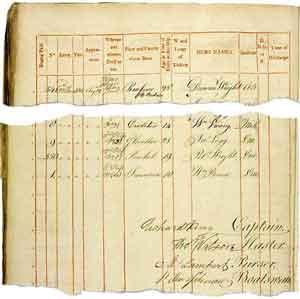Felix Lapham born about 1787, at Trafalgar 21 Oct 1805, died 12 Apr 1814
 The National Archives Exhibitions & Learning online British Battles: "Extract from Royal Navy ship's muster
The National Archives Exhibitions & Learning online British Battles: "Extract from Royal Navy ship's musterExtract from the ship's muster of HMS Achilles, for the Battle of Trafalgar (21 October 1805), including the name of William Vicary, midshipman.
Catalogue reference: ADM 37/52 (1 Oct 1805 - 31 March 1806)"
FELIX LAPHAM was born Abt. 1787 in Williton, a chapelry in the parish of St. Decuman , Somerset, England, and died 12 Apr 1814 in Haslar Hospital, Gosport Portsmouth, Hampshire.
Notes for FELIX LAPHAM:
Felix Lapham.
Ship: HMS Achille
Rank/Rating: Private, Marine
Service details

HMS Achille
Ship's pay book number: (SB 14)
12 April 1805 to 29 February 1812 (Was at Trafalgar)
Comments: Discharged 5 Oct 1813 Haslar Hospital.
Janice Walker
Hugh - did it now rather than later so I don't forget. Felix was a Royal Marine. These are the details I have:-
Born - Wilmerton, Somerset (Williton)
Aged 18 in 1805
Date of Enlistment 28 Feb 1805
Trade on entering the Service Sawyer
Height on entering the Service 5' 4"
Brown hair, fair complexion, grey eyes.
Joined ship HMS Achilles 12 Apr 1805
Royal Marines Light Infantry
Plymouth Division Company 117
On board on 21 Oct 1805
Wounds -None Known
Awarded Prize Money of £1 17s 8d
Died 12 Apr 1814 Haslar Hospital
I go to Kew every so often and I'll see if there are any details under the Royal Marine attestation and Discharge section but this might be a bit too early.

More About FELIX LAPHAM:
Military service: Bet. 1805 - 05 Oct 1813, Rank/Rating: Private, Marine Ship: HMS Achille Ship's pay book number: (SB 14) 12 April 1805 to 29 February 1812 (Was at Trafalgar) Comments: Discharged 5 Oct 1813 Haslar Hospital
note
St Luke Haslar Hospital
County Sources:
Hampshire & Isle of Wight: "ALVERSTOKE parish registers
Haslar Hospital
C 1829-62 B 1827-52 [105]"
GENUKI: The National Gazetteer (1868) -

Alverstoke: "Haslar hospital is in this parish. It is a spacious brick building near the entrance to Portsmouth harbour, extending in front about 570 feet, and having two wings about 550 feet in length. It is capable of receiving 2,000 patients. It contains besides apartments for the governor, officers, and nurses, a chapel and a museum. The grounds belonging to it extend nearly a mile. It was erected on the suggestion of Earl Sandwich, about the middle of the 18th century. Soldiers form a large class of the population of Alverstoke. The town was within the jurisdiction of the Cheyney Court at Winchester.
See "GOSPORT, a parish chapelry, seaport, market, and post town, in the parish and liberty of Alverstoke, county Hants, 23 miles S.E. of Winchester, and 77 from London by the turnpike road, or 96 by the South-Western railway, which has a branch line to this place. It is situated on the western side of the entrance to Portsmouth Harbour, on a point of land facing the town of Portsmouth, from which it is distant, at one part, only half a mile, and with which there is constant intercourse by means of a steam ferry, and a floating bridge conveying passengers, carriages, horses, and all kinds of merchandise. Gosport is, comparatively, a modern town, deriving its importance, chiefly, from its proximity to Portsmouth.
It appears that King Stephen succeeded in landing here, after being driven about in a storm, and called it God's Port. He afterwards bestowed it upon his brother, the Bishop of Blois, who granted it a charter. The town is well built, and, especially from the water, has a handsome appearance. It is governed in matters relating to its sanitary and social condition by a body of trustees appointed under a local Act of Parliament, who make and levy all rates for paving, lighting, &c. There are also two officers, called constables, chosen under the ancient charter.
The town contains a market-house, theatre, commercial and savings banks, house of correction, foundries, breweries, and extensive works connected with the government establishments, affording employment to a large number of people. Here are situated the Royal Clarence victualling-yard for supplying her Majesty's navy, extensive powder magazines, the Forton marine barracks, and the Haslar hospital, capable of accommodating 2,000 inmates. Within a short distance of the above hospital are the two powerful batteries known as the Block House and Monckton forts; other defences are in process of construction. The coastguard and police services have stations here. It is a polling-place for the county, and petty sessions are held fortnightly.
The living is a perpetual curacy* in the diocese of Winchester, value £220, with good parsonage house, in the patronage of the Rector of Alverstoke. The church, dedicated to the Holy Trinity, was originally erected in 1696, and has been subsequently much enlarged. It was entirely repaired in 1830 at the cost of £4,000. Its internal appearance is very handsome. There is also the district church of St. Matthew, the living of which is a perpetual curacy, value £200, in the gift of the bishop and rector alternately. The Independents have two chapels, and the Wesleyans and Roman Catholics one each. There are five National schools, and two free schools, one in connection with Trinity church, and one a Roman Catholic school. The Bishop of Winchester is lord of the manor. Tuesdays and Saturdays are the market days."

Sir William Burnett Library photos by the librarian Michael Rowe


0 Comments:
Post a Comment
<< Home